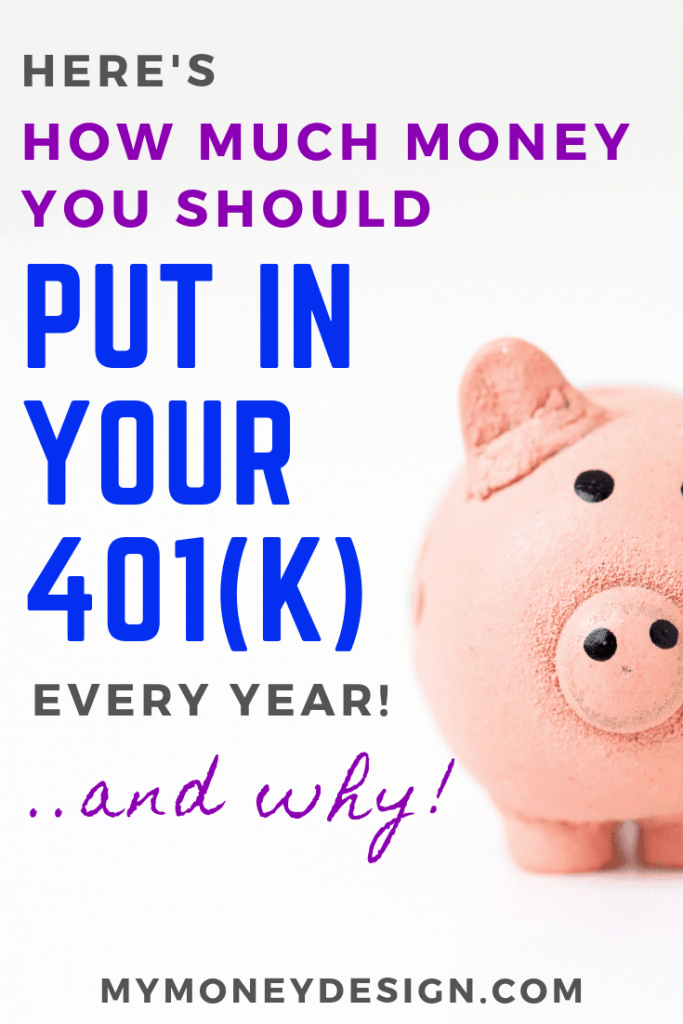Seriously … what’s the magic answer? Is it 5%? 10%? 15%?
Take a stroll around the Internet, and you’re bound to find a number of opinions from reputable sites. For example, Investopedia is quoted as saying that “a good sweet spot is between 10% to 15%”.
That’s not surprising; especially when you consider that when you’re young (in your 20’s and 30’s) and just starting out, retirement can feel like such a long ways away.
You know you should be saving up for the future. But at the same time you’ve got to balance your finances against goals that are in the present such as your family needs, housing, vehicles, etc. And so 10% to 15% seems like a good compromise. (… The only problem is that we tend to contribute much less than that; 6.2% according to Vanguard.)
While all of this may be fine and good, I believe that if more people were to look at contributing to their 401(k) accounts the way that I’m about to show you, then they would be saving a WHOLE LOT MORE!
As you’ll see, it’s a grand opportunity to take advantage of some major, major savings.
This is why when people ask how much they should be contributing to their 401(k)’s, my answer is simple: Contribute the max!
Why You Should Contribute as Much as Possible and Max Out Your 401(k)
- Full price or
- On sale?
I think most of us would agree that “On Sale” is the way to go! And if you’re anything like me, then you LOVE getting a good deal on something you were planning to buy anyways.
Well, believe it or not, this simple analogy applies to your retirement savings too. You have the option to either:
- Save a portion of your paycheck in a regular bank account.
- Save a MUCH LARGER portion of your paycheck without any extra effort using your 401(k)!
How is that possible?
Simple … by legally avoiding paying TAXES!
But what’s even more interesting is that this savings can be scaled! The more money you decide to put in your 401(k), the more money that you end up saving! Therefore, it would make sense to bump your contribution rate up as high as possible!
Let’s break this down using a single dollar as an example …
Saving 28% More of Your Money
For every dollar you earn, you know that you must pay taxes on it.
Using the Federal average tax rate of 22%, this means that:
- For every $1.00 earned,
- Roughly $0.22 goes to taxes and
- Roughly $0.78 is leftover for you to save, spend, … do with as you please.
This means that if you simply put your money in a bank account after taxes are paid, for every $1 you had hoped to save, you’re really only saving $0.78 of it.
That’s NOT a very good deal.
Now let’s look at how this works when we use a 401(k) instead:
- For every $1.00 earned,
- $0 goes to taxes. Remember that with a 401(k), you get to defer your taxes for decades later into the future until you are finally withdraw the money.
- Therefore, the whole $1.00 gets saved!
This is the fundamental benefit of using a 401(k) to save for retirement. You get to keep both the $0.78 you would have saved PLUS the $0.22 you would have paid towards taxes!
Which would you rather have available to save: $0.78 or $1.00?
Clearly being able to save the $1.00 using a 401(k) is the better choice! That’s roughly ($1 – $0.78) / $0.78 = 28% more for doing nothing more than being smart about how you save your money!
So, now that you understand how tax-advantaged savings with a 401(k) works, how can you use this information to get the MAXIMUM amount of benefit?
As I said before: MAX out your savings; all the way up to the IRS contribution limit!
Let me show you why.
How Saving the IRS Max = +$4,000 Saved!
As of 2019, the IRS will allow each U.S. worker to contribute as much as $19,000 to their 401(k) plan every year.
Let’s reach for the stars for a minute and consider what the benefit would be if you contributed enough money to your 401(k) to hit this upper limit.
Using the same numbers as our previous example, we now have:
- $19,000 is earned,
- $19,000 x 22% = $4,180 goes to taxes and
- $14,820 is leftover for you to save.
But again, by saving our money using our 401(k):
- $19,000 is earned.
- $0 goes to taxes. (Taxes are deferred.)
- Therefore, the whole $19,000 gets saved!
Again, by using your 401(k), you get to keep both the $14,820 you would have saved PLUS the $4,180 you would have paid towards taxes!
How many other strategies do you know of where the benefit is getting to save an extra +$4,000? To me, this is an incredible incentive to reach that IRS upper limit each and every year.
Bonus tip: Keep in mind that this strategy works per person. If you’re a couple and you both contribute to your own 401(k) plans, you have the opportunity to actually DOUBLE this benefit by saving $4,180 x 2 = $8,360 per year!
Tax-Deferred Growth for Years to Come
If that’s not already awesome enough, now consider this: All that extra savings will now grow and compound each year tax-deferred!
Remember that your 401(k) isn’t just a savings account. It’s an investment account. This means that every dollar extra you contribute has the capacity to grow and multiply for years and years to come.
This additional savings of +$4,000 is no small addition. If we look at just the difference this amount makes by NOT going to taxes, we can calculate that $4,180, over the next 30 years at a rate of 7% annually has the potential to increase to as much as $394,846.
That’s a pretty substantial increase to your nest egg!
Saving More is the Quickest Path to Financial Freedom
But there is also another very IMPORANT benefit …
A high level of personal savings is the quickest and surest way to achieve financial freedom!
Believe me. I’ve read hundreds of F.I.R.E (financial independence, retire early) stories. And almost every time, behind each one, you can find that the individual or couple used a high level of savings in order to achieve their goal. In fact, here are six F.I.R.E. stories that you can check out for yourself.
I’m not talking in their 50’s and 60’s. These are people in their 40’s or even 30’s who became so financially stable that they were able to walk away from full-time employment and go do whatever makes them happy.
How is this possible?
It’s due to something I call the double-ended approach to early retirement. By saving more, you essentially teach yourself to live off of less money. This then leads to you needing less money to achieve financial freedom. And thus you reach your goal faster. You can read all about it in this post here.
So now you’ve got two VERY good reasons to strive to max out your 401(k): Keeping more of your tax money for yourself, and reaching financial freedom quicker!
Great! Now How Do I Get My Savings Rate So High?
Being able to contribute all the way up to the IRS 401(k) max is not something that most people will be able to do overnight.
Just like someone on a diet who wants to lose weight, it’s going to take a lot of discipline and will-power to get there. But given time, if you stay consistent, you will reach your goal!
It look us years to get to the point where my wife and I could each hit the IRS max limits. We started off much like everyone else contributing 10% or so to our plans. But little by little, we kept increasing our contributions until we had finally hit the ceiling.
How did we do it?
My favorite strategy is a little something I call the 401(k) raise ratchet method.
What’s that? It’s a simple little trick where you raise your contribution level every time you get a new raise at work. By doing this, you never end up missing the money because you never know any different from the previous year.
Here’s a more detailed article I wrote about how the 401(k) raise ratchet method works and why it’s so effective. I can definitely vouch for it – it was the strategy I used to slowly bump up our savings rate all the way up to the max!
Other good tips you’ll find helpful:
- The 10 Best Practical Ways to Budget Your Money and Save More
- Monthly Budget Not Working? Why An Annual Budget Is Better
- Our All-Inclusive Trip to Los Cabos, Mexico & How We’ve Saved $4,247 in Travel This Year
At a Minimum, Get the Full Employer 401(k) Match
Okay, okay. I perfectly understand that saving all the way up to the 401(k) maximum limit will not fit into everyone’s financial situation.
My goal here was to illustrate just how great this strategy can be if you scaled it for maximum benefit.
At the absolute minimum, there is one threshold you should under no circumstances go below: Contributing as much as needed to get the full 401(k) employer match.
For me, this is the one number that is non-negotiable.
Why? Because anything less than this and you are simply passing up FREE money.
Most U.S. employers will now pay an incentive to their employees in the form of a 401(k) match. Sometimes this might be 50 cents to a dollar. Or sometimes its as much as dollar for dollar. On average, this works out to a match of roughly 2.7% of the employees pay.
Keep in mind that just like your 401(k) contributions, this money is tax-deferred too – meaning you pay no taxes on it right now. PLUS: It grows tax-deferred too!
So if you contribute anything less than this amount to your 401(k), you’re simply leaving money on the table. A LOT of money over time!
Don’t believe me? Just check out how much more that can build up your 401(k) over time at this post here.
To know for sure what this minimum amount should be, go to your 401(k) provider or HR representative and get the details. Every employer’s rules will be different.
What If I Don’t Like My 401(k) Plan or Can’t Contribute to One?
Unfortunately, not all 401(k) plans are the same.
Some offer really good terms while others …. not so much. It all depends on how your employer has setup the plan.
Consider:
- Some have lousy or expensive investment options
- Some plans charge high administrative fees.
- Some don’t allow you to borrow or make it nearly impossible to make a withdrawal, even with a financial hardship.
- Some won’t let you file for a 72t or SEPP if you plan to retire early.
If you have encountered these problems or your employer simply doesn’t offer 401(k) plans, relax.
The IRS also gives the option to contribute to a Traditional or Roth IRA. Like a 401(k), these savings plans allow you to make tax-advantaged contributions that can grow and compound your nest egg. But the major difference is that an IRA is under your control; it is completely separate from your employer.
To find out more, check out everything you could ever want to know about Traditional vs Roth IRA’s in our extensive article here.
Also, if you’d like more details on how IRA’s differ from 401(k) plans, then please read this post too.
But How Do I Know Exactly How Much I Should Be Saving?
But how does someone find out what they number is?
With all the noise that’s out there in financial media, it’s a wonder anyone knows what’s real and what’s just there as link-bait.
I’ve read everything from articles suggesting you save up multi-million dollar nest eggs to moving to third-world countries for retirement. No thanks!
Over time, as I tested my own plans, it became clear to me that a lot of what I was doing could be used by others to help them realize their paths to financial freedom too.
This is what inspired me to write my book “How Much Money Do I Really Need to Retire & Achieve Financial Independence?”.
In it, we take a very straight-forward and practical approach to answering the question: How much do I really need to save? What you’ll discover is that depending on how you want to live in your retirement, you might not need millions of dollars at all. In fact, you might be just as safe and secure with less; not to mention a whole lot happier you were able to stop working much sooner.
If you’d like to see more, please feel free to check it out on Amazon, available in digital and paperback format.
Readers – What do you say to someone who asks: How much should I contribute to my 401(k) plan? What amount or percentage do you feel is good, and what’s your strategy behind it?
Photo credits: Flickr, FreeDigitalPhotos, Flickr








Compound interest is the secret. We should take advantage of our youth and save big now instead of later.
Your “older self” will thank you if you do.
I think saving early and often is the best way. Young people should try and get in a habit of saving from the start. I would say try and save more then the standard 15-20%. I think this rule is out dated. If the company matches definitely take advantage of free money.
I did see one article from Wade Pfau that said that ~17% savings was the optimal rate. But it also assumed 30 years of work. If you’re like me, then 30 years is way too long.
I’m currently saving %50 of my total income and putting it in low risk investments. At my current rate I should have enough passive income in 5 years that I could work a part time if I felt like it.
We’re working on just maxing out two IRAs for 2014! Even that amount is well above 15% of our gross income, which is the minimum that we save. My husband just got access to his first workplace-based retirement plan over the summer, but we aren’t contributing to it until after I resume working. 🙂 Decreasing our tax burden isn’t a focus for us right now as we are in the 15% tax bracket, but compound interest definitely is.
Nice work on those IRA’s! At a minimum it sounds like the two of you at least have a plan and an eventual goal in mind of where to go with your retirement savings. I knew saving the full 401k amount was going to be a stretch for most people, but its the direction I believe most of us should look towards heading.
I second your advice. If you are just starting out and going from basically no salary at all, you can learn to live on what you bring home. If you learn to live on a salary without contributing to retirement, it’s much harder to adjust contributions upward later down the line, especially if you have bought a house, a car, or had children. I really wish I’d done that from day one!
Good point! By contributing more to your retirement accounts you’re actually conditioning yourself to figure out how to live off of less income and be comfortable. And all that does is just decrease the amount of money we actually need to one day retire because now our standard of living is much lower than what we actually earn.
Example: If you make $60K but save 50% of your income and are living just fine, then you really only need $30K to one day retire. That cuts your retirement nest egg down from $1.5M to $750K. I believe this is the method that Jacob from ERE and Mr Money Mustache used to retire at age 30.
A great answer to a commonly-asked question — awesome post!
Thank you!
Regardless of whether your company offers a 401K or Roth 401K, you should contribute at least the minimum amount to obtain the maximum match from your company. I am not a big fan of the regular 401K or regular IRA since I believe that everyone’s tax rates are going to go up in the future whether through reduced deductions, increased tax rates or other means. For this reason, I would much rather pay the tax today and put my money in a Roth IRA or Roth 401K where it will grow tax-free and when I am ready to withdraw in the future, it comes out tax-free.
The debate about Traditional or Roth is always a tricky one because no one really knows what our taxes will be like in 10, 20, or even 30 years. You can see all the historical ones here at this link, but that doesn’t take into account upcoming unpredictable events like wars, recessions, etc.
I do know that if taxes don’t change and your standard of living stays about the same, then the Traditional does mathematically work out to be the better deal. Read my post here. But again everyone’s situation is just a little bit different and a Roth could still fit yours better.
well stated, MMD..
i am still amazed that some people pass up on their company 401k match.. it’s free money!
That part makes no sense to me. Some people are willing to work overtime or weekends just to make a few extra bucks. But then when it comes to the 401k match they pass it up. I think I would dig pretty deep to do whatever I have to do to get the full amount.
I and my wife have maximized two IRAs. Basically, we are hoping that the sooner we plan for retirement the better and more secured we will get. We are boosting any means to reach our ideal retirement savings.
The small company I work for doesn’t offer a 401k so I don’t have the option of saving $18k/year pre-tax! boo hoo. But I do have a Roth IRA with automatic transfers from my checking the monday after my paycheck clears on track to max out the Roth. I think that’s about all I can afford to save at this point but I guess in the future I’ll have to open a taxable investment account….?
I usually tell people to save at least 15% when they ask me. Most times I get a look back along the lines of 15% is way too much money! I learned a long time ago that I never miss the money that gets taken from my paycheck. I learn to live on what is left over. This is why I make sure to pay myself first with all of my investing/savings. I save first and learn to live on what is left over.
Max that ish out! No excuses.
I started out saving 5% the first year (to get the 5% employer match) and since then I’ve increased by 1% each year (except last year as my salary didn’t go up and my tax withholdings did). With my new employer’s match I’m saving about 15% of my salary in my 401K plan.
I agree to just boil the advice down to as much as you are allowed. I see that most employees don’t contribute very much as a percentage of each check. I am glad companies are auto-enrolling and making new employees opt out of the 401k or 403b instead of opting in. Many peopl will start saving and not even realize it!
I’m personally opting out and investing in much higher yielding things. I should be able to make more than my company would match in the long run with the compound interest.
You’ll be surprised to know that a lot of employees are not contributing to their 401k. I personally know of a couple. They said they simply do not care. My first two years at work, I was contributing 3% of my salary. After those two years, I started maxing out my contributions and that was one of the best financial moves I’ve ever done in my life.
Sadly, I’m not surprised how low the number of participants there are. I used to be a manager, so I saw first hand which employees did and did not contribute. It was really, really unfortunate. But moreso because they did not care.
Nice work maxing out! Glad to hear you’re taking advantage of it.
Good article, nice to put the savings into perspective and see it visually. It’s hard for young people to see the benefit, when the rewards they will reap won’t be realized for many years when they actually reach retirement age. I agree everyone should at the very least capitalize on employer matching. The only catch is if you can get a higher return on non tax-advantaged investments… is it smarter to max out a 401k for a stable 5-7% ROI until retirement age, or is it smarter to be aggressive in one’s youth, seeking out 10-12%+ ROI in non tax-advantaged investments?
It’s a balancing act, to be sure, but I like where you’re coming from.
My company did not offer a 401k until I had worked there for nearly ten years. So I started late but maxed out my contribution every year after that. Just doing that made us 401k millionaires well before reaching traditional retirement age.